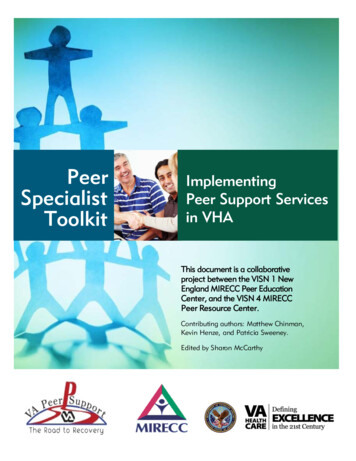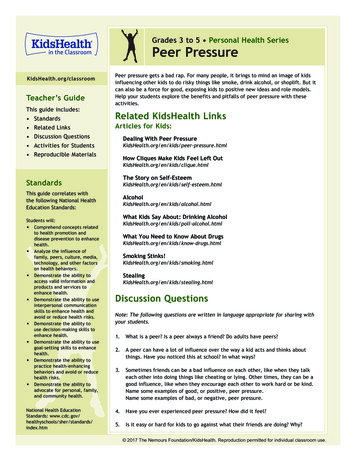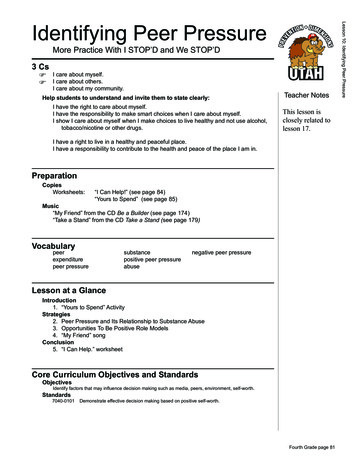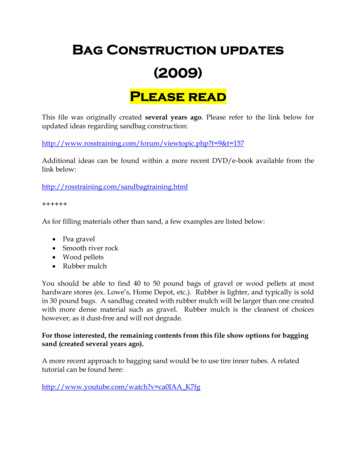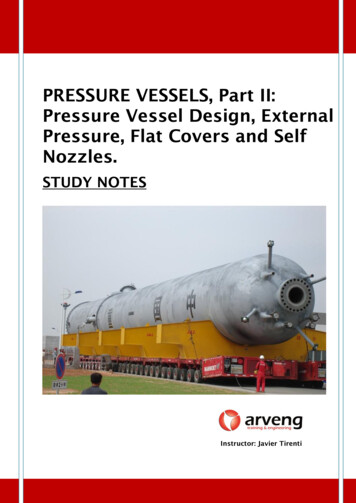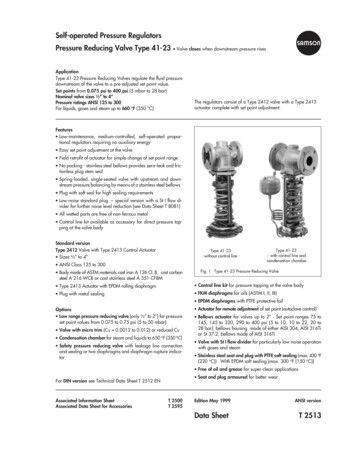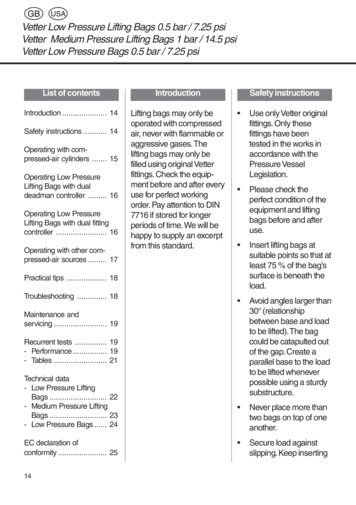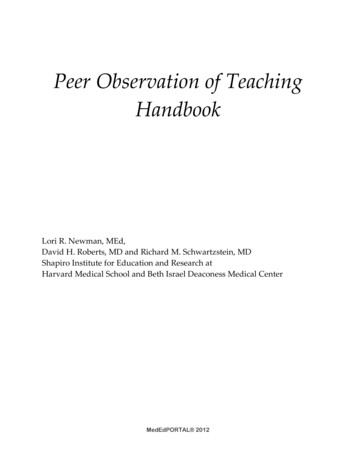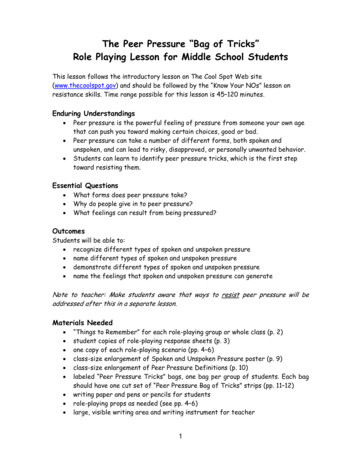
Transcription
The Peer Pressure “Bag of Tricks”Role Playing Lesson for Middle School StudentsThis lesson follows the introductory lesson on The Cool Spot Web site(www.thecoolspot.gov) and should be followed by the “Know Your NOs” lesson onresistance skills. Time range possible for this lesson is 45–120 minutes.Enduring Understandings Peer pressure is the powerful feeling of pressure from someone your own agethat can push you toward making certain choices, good or bad.Peer pressure can take a number of different forms, both spoken andunspoken, and can lead to risky, disapproved, or personally unwanted behavior.Students can learn to identify peer pressure tricks, which is the first steptoward resisting them.Essential Questions What forms does peer pressure take?Why do people give in to peer pressure?What feelings can result from being pressured?OutcomesStudents will be able to: recognize different types of spoken and unspoken pressure name different types of spoken and unspoken pressure demonstrate different types of spoken and unspoken pressure name the feelings that spoken and unspoken pressure can generateNote to teacher: Make students aware that ways to resist peer pressure will beaddressed after this in a separate lesson.Materials Needed “Things to Remember” for each role-playing group or whole class (p. 2)student copies of role-playing response sheets (p. 3)one copy of each role-playing scenario (pp. 4–6)class-size enlargement of Spoken and Unspoken Pressure poster (p. 9)class-size enlargement of Peer Pressure Definitions (p. 10)labeled “Peer Pressure Tricks” bags, one bag per group of students. Each bagshould have one cut set of “Peer Pressure Bag of Tricks” strips (pp. 11–12)writing paper and pens or pencils for studentsrole-playing props as needed (see pp. 4–6)large, visible writing area and writing instrument for teacher1
Procedure Organize the class into six small groups. See role play scenarios and decidewhether to have six mixed groups (i.e., boys and girls), or four mixed groupsplus one group of all boys (for Scenario A), and one group of all girls (forScenario F).Provide the “Things to Remember” notes (see below) as a handout to eachgroup or post an enlargement for the class.Give each student a Student Response Sheet.Give each group a scenario to role play.Give each group a “Bag of Tricks.”Have each group select a spokesperson to hold up the group’s answer choicesfrom the “Bag of Tricks.”Have the groups empty their bags and spread out the papers.Allow the groups enough time to plan and practice their scenarios.Call the groups up one at a time for their role plays (set appropriate groundrules if needed in addition to the “Things to Remember” list).Call “Freeze” at the end of each role play; then have the role players relax.Have each group’s spokesperson hold up the paper strip for the Trick theythink is being demonstrated.Read aloud each choice; then announce the correct answer.Ask students to explain their choices; allow time for Q&A and for the class tofill in their Student Response Sheets.Things to Remember Don’t tell any of the other groups which “Trick” you are presenting. Involve everyone in your group; treat everyone in the group respectfully. Do not use a specific situation that people can identify or that will embarrassanyone. Demonstrate the “Trick” well enough for other students to identify it. Do not use any word that sounds like the “Trick” you are demonstrating (e.g.,don’t say “reject” during the “Rejection” scenario). The person being pressured may react but is not to respond verbally to thepressure. All players are to stop when the teacher calls “Freeze” at the end of thedemonstration. Wait until the teacher signals you to relax.2
Student Response SheetComplete the chart below as you watch the Peer Pressure role plays. Use the CoolSpot Web site (www.thecoolspot.gov) and the resources from your teacher to helpyou identify the “Tricks.” Use your own words or the word bank to describe thefeelings of the person being pressured.Feelings Word Bank:scaredcalmcoolstupidembarrassedabandonedout of controlin controlconfusedobviousignorantimportantSpoken or UnspokenPressure(write one)angryinvisiblesmartexcitedPeer PressureTrick(write one)Team FansSubstituteTeacherMath TestThe PartyThe DanceThe MP3 tdisrespectedpowerlessFeelings(write morethan one)
Role Play ScenariosScenario A – Team Fans (don’t tell other groups—this “Trick” is “Rejection”)Characters:Josh – a boy who has just moved to the areaSeveral other boys who are local team fansSetting: Outside the building before or after school or in the cafeteria during lunchAction: Several boys are standing together discussing their favorite team.Josh walks past.One boy calls out to him and asks who his favorite team is.Josh answers with the name of another city team.All the boys laugh and turn away from Josh.Another boy calls out, “I guess YOU won’t be at our (team name) party Sunday!”Josh walks away.FREEZEScenario B – Substitute Teacher (don’t tell other groups—this “Trick” is “The Put Down”)Characters:Brianna – a polite, respectful middle school studentOther less respectful and somewhat rowdy studentsMr. /Ms. Morgan – substitute teacherSetting: A middle school classroomAction: Brianna enters the class, greets the substitute, sits down, and prepares to work.Other students enter, notice the substitute, and start spreading the word that there’s asub.The bell rings, and other students continue to stand and talk, etc.The substitute asks each of the other students to take their seats and quiet down for themorning announcements.Brianna remains seated quietly while other students continue laughing, messing around,and throwing paper wads, some directed at Brianna.Brianna ignores the disruption.One student calls Brianna a chicken and adds noises; then others make comments to herabout her being a brown-nose or teacher’s pet.FREEZE4
Scenario C – The Math Test (don’t tell other groups—this “Trick” is “Reasoning”)Characters:Pete – a kid who didn’t study for a math testOther students, friends of Pete, who did not study but have a “cheat sheet”Mr. /Ms. Ramos – the math teacherSetting: a middle school classroomAction: Pete comes into the classroom and hears the teacher say there’s a math test.Pete mutters something about his mom’s reaction to another failed math test.Friends overhear Pete and tell him not to worry; they’ve got him covered with the “cheatsheet.”Pete hesitates and expresses concern about cheating and getting caught.Friends give him reasons why they think it’s fine—such as everyone does it, they’ve done itbefore, and they didn’t get caught.FREEZEScenario D – The Party (don’t tell other groups—this “Trick” is “The Huddle”)Characters:Katrina – a nice girl who likes a cool boy and wants to be popularMick – the cool boy that Katrina likesOther cool kidsSetting: an end of school year party Mick and other kids are gathered in a huddle around one student who is showingthem a new music video on a portable media player. They are enjoying the video.Katrina walks in.A few in the group turn and briefly look at her and then at Mick. They don’tacknowledge her and turn back to the video.Mick smiles at her and then gives his attention back to the video and the group.She approaches the group, but they don’t turn to include her.FREEZE5
Scenario E – The Dance (don’t tell other groups—this “Trick” is “The Look”)Characters:Diana – a shy girl wearing simple, plain clothingRafe – Diana’s shy best friend, also dressed in a plain wayOther “popular” students wearing stylish jeans and casual shirtsSetting: a school danceAction: The students in the stylish clothes are dancing and laughing.Diana and Rafe enter and stand apart, watching the others.One or two of the popular students notice Diana and Rafe and give them “the look,” whichcan include looking them up and down, rolling their eyes, slightly shaking their heads indisapproval, and the like. They also nudge their friends—without saying anything—to lookas well.FREEZEScenario F – The MP3 Player (don’t tell other groups—this “Trick” is “The Example”)Characters:Nicky – a girl who wants to fit in.Other girls who are friends with each other and who all have MP3 players with earbudsNicky’s momSetting: the mallAction: Nicky’s mom drops her at the mall to get new athletic shoes and other team equipment.As Nicky is walking to the shoe store, she passes the girls listening to their MP3 playersand sharing their earbuds.Instead of going to the shoe store, Nicky heads for the electronics store and gets an MP3player.When her mom meets her, Mom asks where Nicky’s new shoes and equipment are.FREEZE6
Direct InstructionUse information from the role plays and Student Response Sheets to reinforce andchart the following information about peer pressure.Peer pressure takes many forms— Spoken pressure: Rejection, Put Down, Reasoning Unspoken pressure: The Huddle, The Look, The ExamplePeer pressure evokes a broad range of feelings— Positive: pride, importance, belonging, etc. Negative: confusion, insecurity, isolation, etc.(use Student Response Sheets for examples)People give in to peer pressure for a number of reasons—to improve social or academic standingto broaden their group of friends or acquaintancesto attract or deflect attentionto avoid negative repercussionsto attract positive feedbackto learn something(other from students)Discussion Questions In the role plays, were there any situations in which the peer pressure couldbe seen as positive? Think about “The Example”—how might Mom see having anMP3 player as a good thing for her daughter? What might be some positiveand negative consequences for Nicky? How might this be different if Nickywere a boy? Which other role play demonstrated that having a certain thingcan help someone feel like they fit in? (“The Look”)Is peer pressure always deliberate?Does peer pressure always say something negative about the person or peopleexerting the pressure? Give examples.Are there any advantages or disadvantages in being (or trying to be) friendswith someone outside your normal social group, as in “The Huddle”?Think about the “Reasoning” role play. Is it more important among middleschool peers to just seem to succeed on school tasks or to really succeed onschool tasks?Is peer pressure exclusive to teenagers? Explain your answer.7
Closing and SummaryNote to teacher: “That’s Me” is a strategy in which the instructor makes a series ofstatements to the group and those to whom each statement applies stand up and say,“That’s Me” and then sit down again. The intent is to have people in the group identifyothers with whom they have something in common. Because of the sensitivity of thistopic, you may adapt this strategy and ask students to simply think their responses.Use “That’s Me” for the following statements:IIIIIIIIhave used unspoken pressure against someone.have had unspoken pressure used against me.have used spoken pressure against someone.have had spoken pressure used against me.have used unspoken pressure to help someone.have had unspoken pressure used to help me.have used spoken pressure to help someone.have had unspoken pressure used to help me.Suggested Follow-up activities to Peer Pressure LessonsAsk students to make note of peer pressure they see being used in at least two ofthe following places within a given time frame (before the next class, by the end ofthe week, etc.) and name the type of pressures exhibited. If possible, they shouldstate whether or not the pressures were successful and how they knew. (Ground rule:nothing too personal or embarrassing.)in school (academically)at the libraryat the mallbetween two adultsbetween two younger childrenin school (socially)at a team or group practiceat homeat workPlay charades or Pictionary using Spoken Peer Pressure expressions and phrases suchas:You’re such a loserI promise I won’t tellWhat a geek/nerd/freakNobody will knowEverybody does it(other suggestions from the class)8
Spoken Pressure – Also called directpressure. It’s when a person asks youdirectly to do something, or saysthings to you that push you toward acertain choice.Unspoken Pressure – Also calledindirect pressure. It’s when nothingis actually said to you, but becauseyou see others doing something, youfeel pressure to do the same.9
Peer –Pressure –someone inyour ownage groupthe feeling that someoneis pushing you towarda certain choice,good or badPeer Pressurethe feeling that someone your own age is pushingyou toward making a certain choice,good or badvisit www.thecoolspot.govfor tips on identifying and resisting peer pressure10
Bag LabelPeer PressureBag of -----------------------------Spoken pressure:REJECTIONThreatening to leave someone out or end a ----------------------------------Spoken pressure:PUT DOWNInsulting or calling names to make someone feel ---------------------------Spoken pressure:REASONINGGiving reasons to do something or why it would be OK to do ---------------------------11
Unspoken pressure:THE HUDDLEA group stands together talking or laughing, maybe looking atsomething you can’t see, with their backs out to ------------------------------Unspoken pressure:THE “LK”Kids who think they’re cool give a lookthat means: “We’re cool and you’re ------------------------------Unspoken pressure:THE EXAMPLEPopular kids simply buy or wear or do something, andbecause they set an example, others want to -------------------------------12
The Peer Pressure “Bag of Tricks” Role Playing Lesson for Middle School Students This lesson follows the introductory lesson on The Cool Spot Web site (www.thecoolspot.gov) and should be followed by the “Know Your NOs” lesson on resistance skills. Time range possible for this lesson is 45–120 minutes. Enduring Understandings Peer pressure is the powerful feeling of pressure from .
